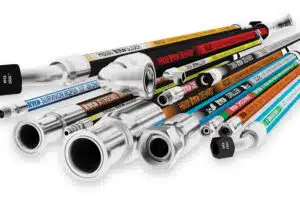The effects of corrosion on our hydraulics system are never good, and they can even be catastrophic. Corroded fittings are one of the key signs you should look for when assessing the health of your hydraulic equipment.
Below, we’ll look at some of the hidden dangers of corrosion in hydraulic machinery to help you understand why regular, professional inspection is essential to determining problems caused by corroded system components.
Problems Caused by Corrosion
Corrosion can cause or contribute to a wide range of problems in a hydraulic system. Corroded couplings can leak, leading to loss of expensive hydraulic fluid. Rust and deterioration from corrosion also makes them weak, increasing the chance of a hose coming loose during operation causing downtime for your company, loss of hydraulic oil, and potential injuries or fatalities.
Corrosion can also affect the protective layer around your hydraulic hoses, increasing the chance of a burst pipe or dangerous pinhole leak. Burst pipes can obviously cause problems, but pinhole leaks are even more dangerous for your workers. They are not easy to detect and can inject scalding hot fluid into the body very quickly – leading to painful injuries, amputation, and even death.
What Causes Corrosion in Hydraulic Equipment
Corrosion is caused by chemical changes in the metallic components of your hydraulic system. This usually stems from two main sources: exposure to corrosive conditions or galvanic corrosion caused by contact between different reactive metals.
Environmental Corrosion
Most corrosion is caused by environmental factors, such as humidity, chemicals, fertilisers, or a marine environment. These factors cause electrochemical oxidation of the metals, leading to rust and structural deterioration. It is important to provide protection for all metal components of a hydraulic system as well as minimising corrosive conditions wherever possible.
Galvanic Corrosion
Galvanic corrosion occurs when two different metals have physical or electrical contact with each other and are immersed in a common electrolyte. In a galvanic couple, the more active metal corrodes at an accelerated rate and the more noble metal corrodes at a slower rate. Steps that can be taken to minimise galvanic corrosion include avoiding contact between reactive metals, removing electrolytes from the equation, or through the use of sacrificial anodes.
Keeping an Eye out for Corrosion
The most obvious sign of corrosion is rust. If any components of your hydraulic machinery exhibit visible rust, have them professionally inspected as soon as possible – as they will most likely need replacement. Corrosion can also be diagnosed retroactively.
For example, if a pipe bursts or a connection fails and you find signs of corrosion around the affected area. Obviously, it’s too late for the individual component involved, but this is a good indicator that you need to improve your anti-corrosion measures. Either work to remove the corrosive elements from your work environment, or if this is impossible – in a marine application, for example – invest in extra corrosion protection.
Talk to the Experts
If you need help diagnosing or fighting corrosion of hydraulics in your workplace, get in touch with the expert team at Hoseright. We can help you find the problem, fix or replace affected parts, and come up with an action plan for fighting corrosion.












